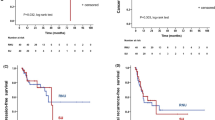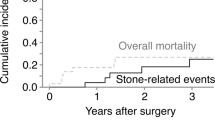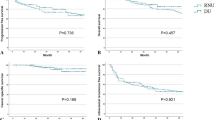Key Points
-
Ureteroenteric anastomotic stricture is a well-known complication of radical cystectomy and urinary diversion and is associated with serious sequelae that can lead to loss of kidney function, infectious complications, and the need for additional procedures
-
The exact aetiology of benign ureteroenteric anastomotic strictures, although unclear, is most likely the result of ischaemia at the anastomotic region
-
Diagnosis can be achieved using retrograde contrast studies, CT scan, or MAG3 renography
-
The gold-standard treatment for ureteroenteric anastomotic strictures is open repair with excision of the strictured segment and reimplantation of the ureter, although this procedure is often challenging and associated with considerable morbidity
-
Endourological techniques have the advantages of reduced blood loss, postoperative pain, and length of hospitalization; however, they lack the long-term patency rates achieved with open revision, and patients often require repeated procedures to maintain patency
-
As stricture length is associated with recurrence, endourological techniques should be reserved for patients with strictures of ≤1 cm in length and for those not suitable for open repair
Abstract
Radical cystectomy and urinary diversion is the gold-standard treatment for muscle-invasive and high-risk non-muscle-invasive bladder cancer. Ureteroenteric anastomotic stricture is a well-known complication of urinary diversion and is associated with serious sequelae that lead to total or partial loss of kidney function, infectious complications, and the need for additional procedures. Although the exact aetiology of benign ureteroenteric anastomotic strictures is unclear, they most likely occur secondary to ischaemia at the anastomotic region. Diagnosis can be achieved using retrograde contrast studies, CT scan or MAG3 renography. Open revision remains the gold-standard treatment for ureteroenteric anastomotic strictures; however, endourological techniques are being increasingly used and, in select patients, might be the optimal approach.
This is a preview of subscription content, access via your institution
Access options
Subscribe to this journal
Receive 12 print issues and online access
$209.00 per year
only $17.42 per issue
Buy this article
- Purchase on Springer Link
- Instant access to full article PDF
Prices may be subject to local taxes which are calculated during checkout







Similar content being viewed by others
References
Anderson, C. et al. Ureteroenteric anastomotic strictures after radical cystectomy—does operative approach matter? J. Urol. 189, 541–547 (2013).
Osman, Y. et al. Comparison between a serous-lined extramural tunnel and T-limb ileal procedure as an antireflux technique in orthotopic ileal substitutes: a prospective randomized trial. BJU Int. 104, 1518–1521 (2009).
Colombo, R. & Naspro, R. Ileal conduit as the standard for urinary diversion after radical cystectomy for bladder cancer. Eur. Urol. 9, 736–744 (2010).
Davis, N. F. et al. Bricker versus Wallace anastomosis: a meta-analysis of ureteroenteric stricture rates after ileal conduit urinary diversion. Can. Urol. Assoc. J. 9, E284–E290 (2015).
Richards, K. A. et al. The effect of length of ureteral resection on benign ureterointestinal stricture rate in ileal conduit or ileal neobladder urinary diversion following radical cystectomy. Urol. Oncol. 33, 65.e1–65.e8 (2015).
Nassar, O. A. & Alsafa, M. E. Experience with ureteroenteric strictures after radical cystectomy and diversion: open surgical revision. Urology 78, 459–465 (2011).
Shimko, M. S. et al. Long-term complications of conduit urinary diversion. J. Urol. 185, 562–567 (2011).
Kouba, E., Sands, M., Lentz, A., Wallen, E. & Pruthi, R. S. A comparison of the Bricker versus Wallace ureteroileal anastomosis in patients undergoing urinary diversion for bladder cancer. J. Urol. 178, 945–948; discussion 948–949 (2007).
Laven, B. A., O'Connor, R. C., Gerber, G. S. & Steinberg, G. D. Long-term results of endoureterotomy and open surgical revision for the management of ureteroenteric strictures after urinary diversion. J. Urol. 170, 1226–1230 (2003).
Farnham, S. B. & Cookson, M. S. Surgical complications of urinary diversion. World J. Urol. 22, 157–167 (2004).
Shah, S. H. et al. Ureteroenteric strictures after open radical cystectomy and urinary diversion: the University of Southern California experience. Urology 86, 87–91 (2015).
Madersbacher, S. et al. Long-term outcome of ileal conduit diversion. J. Urol. 169, 985–990 (2003).
Katkoori, D., Samavedi, S., Adiyat, K. T., Soloway, M. S. & Manoharan, M. Is the incidence of uretero-intestinal anastomotic stricture increased in patients undergoing radical cystectomy with previous pelvic radiation? BJU Int. 105, 795–798 (2010).
Hautmann, R. E., de Petriconi, R. C. & Volkmer, B. G. 25 years of experience with 1000 neobladders: long-term complications. J. Urol. 185, 2207–2212 (2011).
Tal, R., Sivan, B., Kedar, D. & Baniel, J. Management of benign ureteral strictures following radical cystectomy and urinary diversion for bladder cancer. J. Urol. 178, 538–542 (2007).
Knap, M. M., Lundbeck, F. & Overgaard, J. Early and late treatment-related morbidity following radical cystectomy. Scand. J. Urol. Nephrol. 38, 153–160 (2004).
Viers, B. R. K., A. Rivera, M. Tarrell, R. Incidence and risk factors of ureteroenteric anastomotic stricture following radical cystectomy with urinary diversion. J. Urol. 193, e345 (2015).
Lambert, D. M., Marceau, S. & Forse, R. A. Intra-abdominal pressure in the morbidly obese. Obes Surg. 15, 1225–1232 (2005).
Schaffler, A., Scholmerich, J. & Buchler, C. Mechanisms of disease: adipocytokines and visceral adipose tissue—emerging role in nonalcoholic fatty liver disease. Nat. Clin. Pract. Gastroenterol. Hepatol. 2, 273–280 (2005).
Evangelidis, A., Lee, E. K., Karellas, M. E., Thrasher, J. B. & Holzbeierlein, J. M. Evaluation of ureterointestinal anastomosis: Wallace versus Bricker. J. Urol. 175, 1755–1758; discussion 1758 (2006).
Chang, S. S., Alberts, G. L., Smith, J. A. Jr & Cookson, M. S. Ileal conduit urinary diversion in patients with previous history of abdominal/pelvic irradiation. World J. Urol. 22, 272–276 (2004).
Lee, C. T. et al. Comparison of modified Taguchi and Bricker ureteral reimplantation techniques after radical cystectomy. Urology 64, 940–944 (2004).
Steinberg, G. Response to Anderson's article: ureteroenteric strictures after radical cystectomy — does operative approach matter? J. Urol. 189, 541–547 (2013).
Kristjansson, A., Wallin, L. & Mansson, W. Renal function up to 16 years after conduit (refluxing or anti-reflux anastomosis) or continent urinary diversion. 1. Glomerular filtration rate and patency of uretero-intestinal anastomosis. Br. J. Urol. 76, 539–545 (1995).
Mansson, W., Ahlgren, G. & White, T. Glomerular filtration rate up to 10 years after urinary diversion of different types. A comparative study of ileal and colonic conduit, refluxing and antirefluxing ureteral anastomosis and continent caecal reservoir. Scand. J. Urol. Nephrol. 23, 195–200 (1989).
Kristjansson, A. & Mansson, W. Refluxing or nonrefluxing ureteric anastomosis. BJU Int. 84, 905–910 (1999).
Pantuck, A. J., Han, K. R., Perrotti, M., Weiss, R. E. & Cummings, K. B. Ureteroenteric anastomosis in continent urinary diversion: long-term results and complications of direct versus nonrefluxing techniques. J. Urol. 163, 450–455 (2000).
Shaaban, A. A. et al. A randomized study comparing an antireflux system with a direct ureteric anastomosis in patients with orthotopic ileal neobladders. BJU Int. 97, 1057–1062 (2006).
Studer, U. E. et al. Twenty years experience with an ileal orthotopic low pressure bladder substitute —lessons to be learned. J. Urol. 176, 161–166 (2006).
Harraz, A. M. et al. Impact of the type of ureteroileal anastomosis on renal function measured by diuretic scintigraphy: long-term results of a prospective randomized study. BJU Int. 114, 202–209 (2014).
Regan, J. B. & Barrett, D. M. Stented versus nonstented ureteroileal anastomoses: is there a difference with regard to leak and stricture? J. Urol. 134, 1101–1103 (1985).
Varkarakis, I. M., Delis, A., Papatsoris, A. & Deliveliotis, C. Use of external ureteral catheters and internal double J stents in a modified ileal neobladder for continent diversion: a comparative analysis. Urol. Intern. 75, 139–143 (2005).
Faulknier, B., Chaksupa, D., Malas, A. & Rosencrance, J. G. Persistent candiduria complicating intraureteral stenting: a case report and review of literature. W V Med. J. 99, 25–27 (2003).
Keane, P. F., Bonner, M. C., Johnston, S. R., Zafar, A. & Gorman, S. P. Characterization of biofilm and encrustation on ureteric stents in vivo. Br. J. Urol. 73, 687–691 (1994).
Mattei, A., Birkhaeuser, F. D., Baermann, C., Warncke, S. H. & Studer, U. E. To stent or not to stent perioperatively the ureteroileal anastomosis of ileal orthotopic bladder substitutes and ileal conduits? Results of a prospective randomized trial. J. Urol. 179, 582–586 (2008).
Mullins, J. K. et al. Ureteral stents placed at the time of urinary diversion decreases postoperative morbidity. Urol. Int. 88, 66–70 (2012).
Large, M. C. et al. The impact of running versus interrupted anastomosis on ureterointestinal stricture rate after radical cystectomy. J. Urol. 190, 923–927 (2013).
Dangle, P. P. & Abaza, R. Robot-assisted repair of ureteroileal anastomosis strictures: initial cases and literature review. J. Endourol. 26, 372–376 (2012).
Desai, M. M. et al. Robotic intra-corporeal orthotopic neobladder during radical cystectomy: 132 patients. J. Urol. 192, 1734–1740 (2014).
Hayn, M. H., Hellenthal, N. J., Hussain, A., Stegemann, A. P. & Guru, K. A. Defining morbidity of robot-assisted radical cystectomy using a standardized reporting methodology. Eur. Urol. 59, 213–218 (2011).
Dasgupta, P. et al. Robotic assisted radical cystectomy: short to medium-term oncologic and functional outcomes. Int. J. Clin. Pract. 62, 1709–1714 (2008).
Butt, Z. M. et al. Does the presence of significant risk factors affect perioperative outcomes after robot-assisted radical cystectomy? BJU Int. 104, 986–990 (2009).
Kang, S. G. et al. Robot-assisted radical cystectomy and pelvic lymph node dissection: a multi-institutional study from Korea. J. Endourol. 24, 1435–1440 (2010).
Kauffman, E. C. et al. Critical analysis of complications after robotic-assisted radical cystectomy with identification of preoperative and operative risk factors. BJU Int. 105, 520–527 (2010).
Ng, C. K. et al. A comparison of postoperative complications in open versus robotic cystectomy. Eur. Urol. 57, 274–281 (2010).
Torrey, R. R. et al. Functional outcomes and complications in patients with bladder cancer undergoing robotic-assisted radical cystectomy with extracorporeal Indiana pouch continent cutaneous urinary diversion. Urology 79, 1073–1078 (2012).
Vandenbroucke, F., Van Poppel, H., Vandeursen, H., Oyen, R. & Baert, L. Surgical versus endoscopic treatment of non-malignant uretero-ileal anastomotic strictures. Br. J. Urol. 71, 408–412 (1993).
Kramolowsky, E. V., Clayman, R. V. & Weyman, P. J. Management of ureterointestinal anastomotic strictures: comparison of open surgical and endourological repair. J. Urol. 139, 1195–1198 (1988).
DiMarco, D. S., LeRoy, A. J., Thieling, S., Bergstralh, E. J. & Segura, J. W. Long-term results of treatment for ureteroenteric strictures. Urology 58, 909–913 (2001).
Milhoua, P. M. et al. Primary endoscopic management versus open revision of ureteroenteric anastomotic strictures after urinary diversion—single institution contemporary series. J. Endourol. 23, 551–555 (2009).
Msezane, L., Reynolds, W. S., Mhapsekar, R., Gerber, G. & Steinberg, G. Open surgical repair of ureteral strictures and fistulas following radical cystectomy and urinary diversion. J. Urol. 179, 1428–1431 (2008).
Schondorf, D. et al. Ureteroileal strictures after urinary diversion with an ileal segment-is there a place for endourological treatment at all? J. Urol. 190, 585–590 (2013).
Gort, H. B., Mali, W. P., van Waes, P. F. & Kloet, A. G. Metallic self-expandible stenting of a ureteroileal stricture. AJR Am. J. Roentgenol. 155, 422–423 (1990).
Barbalias, G. A., Liatsikos, E. N., Karnabatidis, D., Yarmenitis, S. & Siablis, D. Ureteroileal anastomotic strictures: an innovative approach with metallic stents. J. Urol. 160, 1270–1273 (1998).
Palascak, P. et al. Treatment of benign ureterointestinal anastomotic strictures with permanent ureteral Wallstent after Camey and Wallace urinary diversion: long-term follow-up. J. Endourol. 15, 575–580 (2001).
Liatsikos, E. N. et al. Application of self-expandable metal stents for ureteroileal anastomotic strictures: long-term results. J. Urol. 178, 169–173 (2007).
Rapp, D. E., Laven, B. A., Steinberg, G. D. & Gerber, G. S. Percutaneous placement of permanent metal stents for treatment of ureteroenteric anastomotic strictures. J. Endourol. 18, 677–681 (2004).
Sanders, R., Bissada, N. K. & Bielsky, S. Ureteroenteric anastomotic strictures: treatment with Palmaz permanent indwelling stents. J. Urol. 150, 469–470 (1993).
Campschroer, T., Lock, M. T., Lo, R. T. & Bosch, J. L. The Wallstent: long-term follow-up of metal stent placement for the treatment of benign ureteroileal anastomotic strictures after Bricker urinary diversion. BJU Int. 114, 910–915 (2014).
Zhang, Z. et al. Progressive ureteral dilatations and retrograde placement of single-J stent guided by flexible cystoscope for management of ureteroenteral anatomotic stricture in patients after radical cystectomy and Bricker urinary diversion. J. Endourol. 29, 90–94 (2015).
Wakui, M., Takeuchi, S., Isioka, J., Iwabuchi, K. & Morimoto, S. Metallic stents for malignant and benign ureteric obstruction. BJU Int. 85, 227–232 (2000).
Kramolowsky, E. V., Clayman, R. V. & Weyman, P. J. Endourological management of ureteroileal anastomotic strictures: is it effective? J. Urol. 137, 390–394 (1987).
Shapiro, M. J. et al. Balloon catheter dilation of ureteroenteric strictures: long-term results. Radiology 168, 385–387 (1988).
Yagi, S. et al. Long-term results of percutaneous balloon dilation for ureterointestinal anastomotic strictures. Int. J. Urol. 9, 241–246 (2002).
Ravery, V. et al. Balloon catheter dilatation in the treatment of ureteral and ureteroenteric stricture. J. Endourol. 12, 335–340 (1998).
Hafez, K. S. & Wolf, J. S. Update on minimally invasive management of ureteral strictures. J. Endourol. 17, 453–464 (2003).
Meretyk, S., Clayman, R. V., Kavoussi, L. R., Kramolowsky, E. V. & Picus, D. D. Endourological treatment of ureteroenteric anastomotic strictures: long-term followup. J. Urol. 145, 723–727 (1991).
Cornud, F. et al. Percutaneous transrenal electro-incision of ureterointestinal anastomotic strictures: long-term results and comparison of fluoroscopic and endoscopic guidance. J. Urol. 155, 1575–1578 (1996).
Preminger, G. M. et al. A multicenter clinical trial investigating the use of a fluoroscopically controlled cutting balloon catheter for the management of ureteral and ureteropelvic junction obstruction. J. Urol. 157, 1625–1629 (1997).
Lin, D. W., Bush, W. H. & Mayo, M. E. Endourological treatment of ureteroenteric strictures: efficacy of Acucise endoureterotomy. J. Urol. 162, 696–698 (1999).
Hibi, H., Ohori, T., Taki, T., Yamada, Y. & Honda, N. Long-term results of endoureterotomy using a holmium laser. Int. J. Urol. 14, 872–874 (2007).
Johnson, D. E., Cromeens, D. M. & Price, R. E. Use of the holmium:YAG laser in urology. Lasers Surg. Med. 12, 353–363 (1992).
Watterson, J. D., Sofer, M., Wollin, T. A., Nott, L. & Denstedt, J. D. Holmium: YAG laser endoureterotomy for ureterointestinal strictures. J. Urol. 167, 1692–1695 (2002).
Laven, B. A., O'Connor, R. C., Steinberg, G. D. & Gerber, G. S. Long-term results of antegrade endoureterotomy using the holmium laser in patients with ureterointestinal strictures. Urology 58, 924–929 (2001).
Bierkens, A. F., Oosterhof, G. O., Meuleman, E. J. & Debruyne, F. M. Anterograde percutaneous treatment of ureterointestinal strictures following urinary diversion. Eur. Urol. 30, 363–368 (1996).
Poulakis, V., Witzsch, U., De Vries, R. & Becht, E. Cold-knife endoureterotomy for nonmalignant ureterointestinal anastomotic strictures. Urology 61, 512–517 (2003).
Wolf, J. S. Jr, Elashry, O. M. & Clayman, R. V. Long-term results of endoureterotomy for benign ureteral and ureteroenteric strictures. J. Urol. 158, 759–764 (1997).
Daniel, O. & Shackman, R. The blood supply of the human ureter in relation to ureterocolic anastomosis. BJU Int. 24, 334–343 (1952).
Author information
Authors and Affiliations
Contributions
N.L. and S.D. researched data for the article and N.L., S.D., R.T. and M.S.K. wrote the article. All authors contributed substantially to the discussions of content and were involved in the review and/or editing of the manuscript before submission.
Corresponding author
Ethics declarations
Competing interests
The authors declare no competing financial interests.
Related links
Rights and permissions
About this article
Cite this article
Lobo, N., Dupré, S., Sahai, A. et al. Getting out of a tight spot: an overview of ureteroenteric anastomotic strictures. Nat Rev Urol 13, 447–455 (2016). https://doi.org/10.1038/nrurol.2016.104
Published:
Issue Date:
DOI: https://doi.org/10.1038/nrurol.2016.104
This article is cited by
-
A modified ureteroileal anastomosis can reduce ureteroileal anastomotic stricture after ileal conduit
International Urology and Nephrology (2024)
-
Is it necessary to perform a retrosigmoid transposition of the left ureter in Bricker Ileal Conduit surgery?
BMC Urology (2022)
-
Impact of radiation on the incidence and management of ureteroenteric strictures: a contemporary single center analysis
BMC Urology (2021)
-
A gravity-assisted approach to the management of urinary diversion: 99mTc-MAG3 diuresis renography with F + 10(sp) method
Annals of Nuclear Medicine (2021)
-
The use of indocyanine green during robotic ureteroenteric reimplantation for the management of benign anastomotic strictures
World Journal of Urology (2019)



